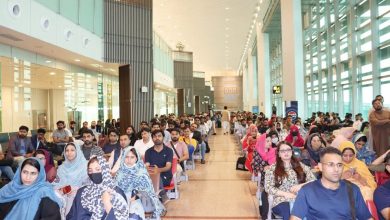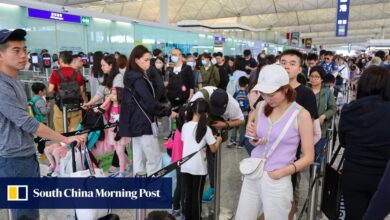The ongoing military overhaul of China’s PLA has one goal in mind: Taiwan

These tensions and the PLA’s growing power will be on the minds of more than two dozen senior defence officials from various countries attending the 10th Xiangshan Forum, a three-day event set to see their opening ceremony Monday in Beijing. The gathering is the first to be held in person since offline events were interrupted by Covid.
But while the military reshuffle can count lots of wins over the past eight years, defence experts argue there remain uncertainties around the PLA’s ability to adapt to the changing face of war, and its readiness to face the major test: Taiwan.
“The realities happening on the Ukraine battlefield have overturned many military doctrines and judgments we learned from previous conventional wars like the Gulf War [in the 1990s].
“We once expected big-scale dog fights and tank battles would become protagonists of the Ukraine war, and infantry would just play an inferior role to clean up in the aftermath … just like what happened during the Gulf War, but the realities showed their roles have been swapped.”
As part of the overhaul, the PLA’s seven military regions were restructured into five theatre commands overseeing different geographic directions, and plans were put in place to trim troop numbers by 300,000 to 2 million.
The PLA’s four independent “military kingdoms” – general staff, general political, general logistics and general armaments – were also abolished, with their powers distributed across 15 smaller units which came directly under the Central Military Commission (CMC).
US lawmakers question Navy over bureaucratic delays for Taiwan weapons
US lawmakers question Navy over bureaucratic delays for Taiwan weapons
Xi also took the title of commander in chief of the PLA’s Joint Operations Command Centre, the first party leader to do so. It was a move designed to help with the CMC chairman accountability system.
“The new commanding mechanism, with the CMC chairman accountability system at its core, aimed at clarifying relationships between joint operational headquarters and the troops, or the PLA’s three new doctrines: CMC instructs top commanders and lets theatre commands oversee military operations, while individual services focus on combat readiness training,” said Zhou Chenming, a researcher with the Beijing-based Yuan Wang military science and technology think tank.
“The moves substantially reduced previous red tape to simplify several rounds of enforcement procedures, building an effective commanding system for the army’s future modernisation.”

China’s rapid economic development has also provided the PLA with a steady increase in the annual defence budget over the past few decades. The military received a 7.2 per cent increase to about 1.55 trillion yuan (US$224.3 billion) this year, making it the second largest defence budget in the world behind the US.
Xi also set a plan in motion to transform the PLA into a fully modern army on a par with that of the United States’ military in the Pacific, which Beijing sees as one of the biggest barriers to reunifying Taiwan.
He wants that achieved by 2027, the year marking the centenary of the founding of the PLA. He also wants the army to “basically complete” its modernisation by 2035, and to become a “world class” military by 2049, the 100th anniversary of the Communist Party’s rise to power.
Supported by the world’s most powerful shipbuilding conglomerate, China remains the biggest maritime force on the globe with an inventory of about 422 vessels, according to US website, the World Directory of Modern Military Warships. The Pentagon annual report expects the number of PLA warships will reach 460 ships by 2030.
Real war is the best test of the success or failure to military reshuffles, otherwise everything is just a theory and weapons are just a heap of metal
But Macau-based military observer Antony Wong Tong said the new warships and hi-tech equipment would only be an advantage if there were enough engineering corps trained in using it.
“Hardware build-up will work only when it can smoothly integrate with software – the human beings,” Wong said. “Real war is the best test of the success or failure to military reshuffles, otherwise everything is just a theory and weapons are just a heap of metal.”
Some military experts have also said the PLA is yet to prove it has kept up with the evolving face of modern warfare.
Ni argued that the Ukraine war has showed how the roles of heavy equipment in air and naval battles are fading.
Meanwhile, Zhou said Beijing has taken note of the fact that the Ukrainian force and Russian army are revising their fighting patterns in prolonged fights, with Moscow replacing its nimble battalion tactical groups with bigger armoured artillery divisions, which are more capable to deal with the well-trained regular Ukrainian troops.
“From Syrian civil war to Azerbaijani and Armenian ethnic and territorial conflict in Nagorno-Karabakh to the Ukraine war, they all remind us that a future warfare is like an examination where you never know its benchmark,” Zhou said.
China exhibition shows latest military advances in drone technology
China exhibition shows latest military advances in drone technology
“The PLA doesn’t know what the next war is going to be like. But a potential fight over Taiwan is the only test that it is more confident to take at the moment.”
Lu Li-shih, a former instructor at the Taiwanese naval academy in Kaohsiung, said the PLA’s efforts to learn how the Americans operated had seen it become a clone of the US military.
“If the PLA wants to surpass its American counterpart, it shouldn’t just imitate – it needs to be creative and innovative,” Lu said.
He added that the PLA’s fighting capabilities in recent years were an indication it has started to come up with its own unique systems and training patterns based on the lessons it has learned from the ongoing Ukraine war and other modern warfare.
While the PLA has not engaged in a real armed conflict for decades, its constant drills around Taiwan potentially give a good indication of how it would undertake such a conflict.
Beijing sees the island as part of its territory and has never ruled out the use of force to take control of it. Most countries, including the US, do not recognise Taiwan as an independent state. Washington, however, opposes any attempt to take the island by force.
The PLA has been preparing for a possible Taiwan war since the Kuomintang fled the mainland to the island in 1949 after its failure in the civil war, with the PLA’s playbook of anti-access and area denial strategy being designed to target the US-led foreign military intervention.
South China Sea: US-China confrontation looms large
South China Sea: US-China confrontation looms large
It also mobilised civilian roll-on/roll-off (RO-RO) ferries to transport troops and trucks in regular amphibious warfare exercises, as well as increasing the deployment of unmanned aerial combat vehicles to enter Taiwan’s air defence identification zone (ADIZ), he added.
“The PLA is ramping up the variety and scale of its air and naval drills near Taiwan, including simulated confrontation war games between the Southern and Eastern theatre commands, island seizure exercises in waters close to Taiwan-controlled islets – and more new tactics are coming,” Lu said.
The reunification of Taiwan was described by Xi as an integral part to realising his goal of “national rejuvenation”, which has also been the key motivator pushing the PLA towards its modernisation.
After decades of modernisation, especially after Xi came to power in late 2012, the PLA has accelerated its reforms and achieved some significant progress, a lot of which would make a difference in a war scenario over Taiwan.
One of the major parts of Xi’s military overhaul has been the establishment of the Strategic Support Force, a new branch running the space, cyber, intelligence and electronic warfare force which provides target acquisition support in all-domain combat operations.
In November 2020, the Chinese defence ministry announced the army had completed military mechanisation, which was the first step for the PLA to reach its initial goal of joint operation.
As part of the mechanisation, the PLA debuted some new weapons on the 2019 National Day parade, including the Dongfeng-17 hypersonic ballistic missile system, and some low-cost, long-range multiple launch rocket systems (MLRS) with precision strike capabilities.
One such weapon was the PCL-191 MLRS, which has a firing range of over 350km, putting the main Taiwan island within its reach.
A rocket is about a third of the cost of a PLA rocket force missile with the same range, which also makes it an affordable artillery for the army to generate saturated fire coverage. Zhou said it would be one of the weapons used in a potential Taiwan conflict.






